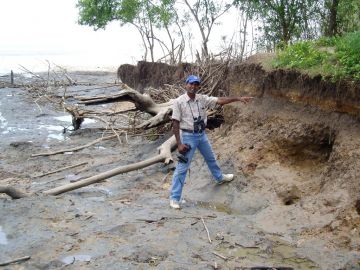Promotion of Sustainable Livelihoods within the Coastal Zone of Suriname


Coastal erosion in Suriname
The Republic of Suriname, situated on the northeast coast of South America, occupies 163,265km² of which about 90% is covered with rainforest. It has a population of approximately 492,829 (August 2005) of which 97% is concentrated in the low-lying coastal zone, and especially in and around the capital city of Paramaribo (about 70%). The remaining 3% of Suriname’s population is spread over small and tribal communities along rivers. The average population density of 2.9 people/km² indicates that Suriname is very sparsely populated. This average stands in stark contrast to the population densities of Paramaribo and Wanica, the two most important coastal districts of the country, of 1,327.6 people/km² and 194.1 people/km² respectively.
Background and Rationale
Studies dealing with climate change and its impacts on the various sectors in Suriname started seriously with the implementation of the first Netherlands Climate Change Studies and Assistance Program (NCCSAP-I). Studies carried out under this first phase convincingly showed that the impacts of sea level rise on Suriname can be significant and the project identified Paramaribo and Wanica as the most vulnerable districts in terms of economic losses and impacts on the population. Apart from sea level rise, it has also been noted that climate change will result in increased climate variability in Suriname, causing abundant rainfall in shorter periods of time as well as prolonged droughts. Both extremes of the hydrological cycle are expected to further add to the negative impacts of climate change in Suriname.
The project ‘Promotion of Sustainable Livelihood Within the Coastal Zone of Suriname, with Emphasis on Paramaribo and the Immediate Region’, which was implemented under the second phase of the Netherlands Climate Assistance Program (NCAP-II), has sought to respond to this need and has worked on the elaboration of a more detailed and specific adaptation strategy for Paramaribo and Wanica. The development of the adaptation strategy included an assessment and evaluation of the feasibility of the proposed measures, a specification of the financial needs for implementing the proposed measures and the identification of potential(international) financial resources. In addition, the project sought to:
• Develop a more detailed picture of the vulnerabilities of the different sectors in Paramaribo and Wanica;
• Contribute towards the formulation of a national climate change policy; and
• Further raise awareness of the issue of climate change among policy makers and the general public.
This project was carried out under the Netherlands Climate Assistance Programme (NCAP)] which was funded by the Netherlands Ministry of Foreign Affairs. The project took place from May 2005 to June 2008. The overall project management in Suriname was in the hands of The Ministry of Labor,Technological Development and Environment (ATM). The Anton de Kom University, in collaboration with local consultants and experts, was responsible for the day-to-day implementation of the project. ETC International managed the overall NCAP project.
Next. . .
On to:
Methodology of Suriname NCAP Project
Key Findings from Suriname NCAP Project
(0) Comments
There is no content